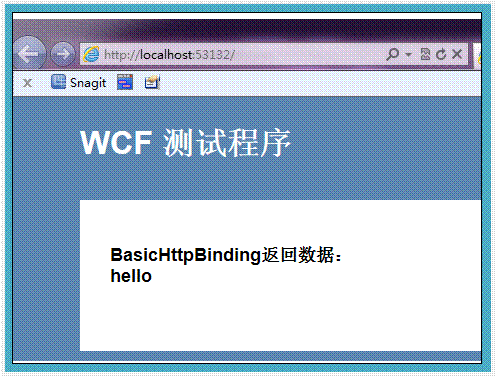WCF BasicHttpBinding 安全解析(3)默认安全设置(IIS宿主)
本节开始的实例采用IIS作为WCF宿主,使用的契约和实现和前面使用的仍然相同,下面我们构建两个站点,一个WCF服务宿主站点,一个服务测试站点。首先我们创建服务端,打开vs2010à文件à新建项目à选择WCF模板àWCF服务应用程序,如图11-31。
图11-31 创建WCF如无应用程序
删除默认添加的SVC文件和接口文件,添加接口文件IHelloService.cs和接口实现文件HelloService.cs,代码内容和前面章节使用的相同。现在按代码清单11-78的方式配置web.config文件。
代码清单11-78 服务端web.config
<?xml version="1.0" encoding="utf-8"?>
<configuration>
<system.serviceModel>
<serviceHostingEnvironment>
<serviceActivations >
<add relativeAddress="HelloService.svc"
service="WcfHelloService.HelloService"/>
</serviceActivations >
</serviceHostingEnvironment >
<services>
<service name="WcfHelloService.HelloService" behaviorConfiguration="WcfHelloService.ServiceBehavior">
<endpoint binding="basicHttpBinding" contract="WcfHelloService.IHelloService">
</endpoint>
</service>
</services>
<behaviors>
<serviceBehaviors>
<behavior name="WcfHelloService.ServiceBehavior">
<serviceMetadata httpGetEnabled="true" />
<serviceDebug includeExceptionDetailInFaults="false" />
</behavior>
</serviceBehaviors>
</behaviors>
</system.serviceModel>
</configuration>
现在我对代码清单11-78中的关键配置做简要的说明。清单中的<serviceActivations>配置节用于添加可定义虚拟服务激活设置(映射到WCF) 服务类型)的设置。使用此配置元素可以在不使用.svc文件的情况下激活承载在WAS/IIS中的服务。上面的配置中我们将WcfHelloService.HelloService服务的请求映射到虚拟的HelloService.svc。配置<serviceMetadata httpGetEnabled="true" />,使得我们可以通过httpGet的方式访问元数据。配置文件配置妥当之后我们打开IIS添加名为wcfservicewebsite.com的站点,目录指向项目所在的本地路径,应用程序池采用.net 4.0,如图11-32。
图11-32 配置服务站点
在浏览器内输入http://wcfservicewebsite.com/HelloService.svc来验证服务是否托管成功,结果如图11-33。
图11-33 从浏览器访问HelloService.svc
图11-33的结果说明服务发布成功,接下来我们创建测试站点,使用vs2010创建一个Asp.net MVC2 Web应用程序,然后添加服务引用,输入服务地址,最后点确定,如图11-34。
图11-34 添加服务引用
添加引用之后,客户端会自动在配置文件中添加如代码清单11-79所示的配置。
代码清单11-79 客户端web.config配置
<system.serviceModel>
<bindings>
<basicHttpBinding>
<binding name="BasicHttpBinding_IHelloService" closeTimeout="00:01:00"
openTimeout="00:01:00" receiveTimeout="00:10:00" sendTimeout="00:01:00"
allowCookies="false" bypassProxyOnLocal="false" hostNameComparisonMode="StrongWildcard"
maxBufferSize="65536" maxBufferPoolSize="524288" maxReceivedMessageSize="65536"
messageEncoding="Text" textEncoding="utf-8" transferMode="Buffered"
useDefaultWebProxy="true">
<readerQuotas maxDepth="32" maxStringContentLength="8192" maxArrayLength="16384"
maxBytesPerRead="4096" maxNameTableCharCount="16384" />
<security mode="None">
<transport clientCredentialType="None" proxyCredentialType="None"
realm="" />
<message clientCredentialType="UserName" algorithmSuite="Default" />
</security>
</binding>
</basicHttpBinding>
</bindings>
<client>
<endpoint address="http://wcfservicewebsite.com/HelloService.svc"
binding="basicHttpBinding" bindingConfiguration="BasicHttpBinding_IHelloService"
contract="HelloServiceReferenceForBasic.IHelloService" name="BasicHttpBinding_IHelloService" />
</client>
</system.serviceModel>
代码清单11-79的配置无需做过多的解释,但是由VS生成的配置文件中我们能看到更多的 默认细节,比如默认的编码方式、凭据类型、安全模式等。
修改HomeController为代码清单11-80所示的内容。
代码清单11-80 调用服务
[HandleError]
public class HomeController : Controller
{
HelloServiceReferenceForBasic.HelloServiceClient client = new HelloServiceReferenceForBasic.HelloServiceClient();
public ActionResult Index()
{
string helloString = client.GetHello();
ViewData["Message"] = helloString;
return View();
}
public ActionResult About()
{
return View();
}
}
在代码清单11-80中,首先声明了变量client,它是客户端代理实例。然后在Index方法中调用client.GetHello()方法,最后将返回的数据赋值给ViewData["Message"],返回的前端。在前端页面,我们通过如代码清单11-81的方式绑定数据。
代码清单11-81 在前端显示请求的到的数据。
<asp:Content ID="Content2" ContentPlaceHolderID="MainContent" runat="server">
<h2>BasicHttpBinding返回数据:<br />
<%: ViewData["Message"] %></h2>
</asp:Content>
下面我们在vs2010中将测试站点设为启动项,开启Http监听工具Fiddler,启动测试站点。结果如图11-35所示。
图11-35 客户端显示取得的数据
从图11-35的结果结合服务端的代码,服务端没有获取安全上下文才返回次结果。下面我们再看Fiddler监听到的数据,请求数据如代码清单11-82所示,响应数据如代码清单11-83所示。
代码清单11-82 客户端请求数据
POST http://wcfservicewebsite.com/HelloService.svc HTTP/1.1
Content-Type: text/xml; charset=utf-8
VsDebuggerCausalityData: uIDPo5jCIjrL22NAjy8DHniBadAAAAAAlMqRQj7B9ka4Fz7jm+jNSHCjeEjI+TVCsG2H2EAUzR8ACQAA
SOAPAction: "http://tempuri.org/IHelloService/GetHello"
Host: wcfservicewebsite.com
Content-Length: 133
Expect: 100-continue
Accept-Encoding: gzip, deflate
Connection: Keep-Alive
<s:Envelope xmlns:s="http://schemas.xmlsoap.org/soap/envelope/"><s:Body><GetHello xmlns="http://tempuri.org/"/></s:Body></s:Envelope>
代码清单11-83 服务端响应数据
HTTP/1.1 200 OK
Content-Type: text/xml; charset=utf-8
Vary: Accept-Encoding
Server: Microsoft-IIS/7.5
X-Powered-By: ASP.NET
Date: Sat, 25 Jun 2011 08:49:31 GMT
Content-Length: 197
<s:Envelope xmlns:s="http://schemas.xmlsoap.org/soap/envelope/">
<s:Body>
<GetHelloResponse xmlns="http://tempuri.org/">
<GetHelloResult>hello</GetHelloResult>
</GetHelloResponse>
</s:Body>
</s:Envelope>
从代码清单11-82和代码清单11-83的数据可以看出默认情况下没有对消息进行加密,也没有任何凭据和认证信息。当然BasicHttpBinding不是一点安全性都没有的,下面的几节我们逐步的武装它。
作者:玄魂
出处:http://www.cnblogs.com/xuanhun/
原文链接:http://www.cnblogs.com/xuanhun/
更多内容,请访问我的个人站点 对编程,安全感兴趣的,加qq群:hacking-1群:303242737,hacking-2群:147098303,nw.js,electron交流群 313717550。
本文版权归作者和博客园共有,欢迎转载,但未经作者同意必须保留此段声明,且在文章页面明显位置给出原文连接,否则保留追究法律责任的权利。
关注我:


 BasicHttpBinding使用HTTP作为传输协议用于发送SOAP 1.1消息。服务可以使用此绑定来公开符合WS-I BP 1.1标准的终结点,如ASMX客户端访问的终结点。同样,客户端可以使用BasicHttpBinding与公开符合WS-I BP 1.1标准的终结点的服务(如 ASMX Web服务或采用BasicHttpBinding 配置的服务)进行通信。虽然很多作者和专家不推荐使用BasicHttpBinding认为其安全性较差,但是它的确提供了完整的安全机制,很多场景满足要求,我们有必要去了解。BasicHttpBinding的安全配置和其他绑定并没有什么太大的差别,对此我们可以由此及彼,举一反三。
BasicHttpBinding使用HTTP作为传输协议用于发送SOAP 1.1消息。服务可以使用此绑定来公开符合WS-I BP 1.1标准的终结点,如ASMX客户端访问的终结点。同样,客户端可以使用BasicHttpBinding与公开符合WS-I BP 1.1标准的终结点的服务(如 ASMX Web服务或采用BasicHttpBinding 配置的服务)进行通信。虽然很多作者和专家不推荐使用BasicHttpBinding认为其安全性较差,但是它的确提供了完整的安全机制,很多场景满足要求,我们有必要去了解。BasicHttpBinding的安全配置和其他绑定并没有什么太大的差别,对此我们可以由此及彼,举一反三。







【推荐】国内首个AI IDE,深度理解中文开发场景,立即下载体验Trae
【推荐】编程新体验,更懂你的AI,立即体验豆包MarsCode编程助手
【推荐】抖音旗下AI助手豆包,你的智能百科全书,全免费不限次数
【推荐】轻量又高性能的 SSH 工具 IShell:AI 加持,快人一步
· AI与.NET技术实操系列:向量存储与相似性搜索在 .NET 中的实现
· 基于Microsoft.Extensions.AI核心库实现RAG应用
· Linux系列:如何用heaptrack跟踪.NET程序的非托管内存泄露
· 开发者必知的日志记录最佳实践
· SQL Server 2025 AI相关能力初探
· 震惊!C++程序真的从main开始吗?99%的程序员都答错了
· 【硬核科普】Trae如何「偷看」你的代码?零基础破解AI编程运行原理
· 单元测试从入门到精通
· 上周热点回顾(3.3-3.9)
· winform 绘制太阳,地球,月球 运作规律